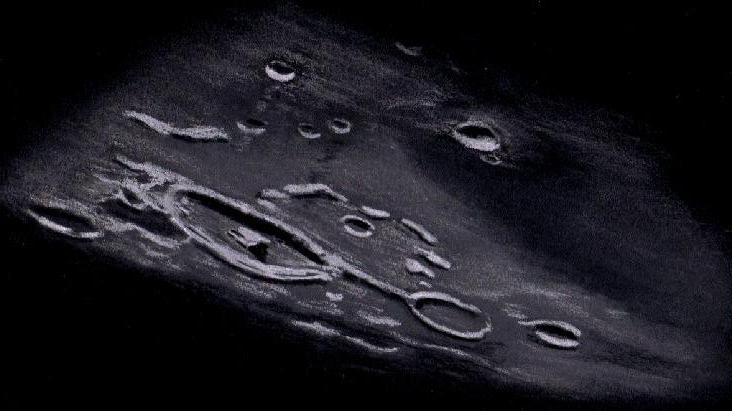It was approaching the time for sunset and Venus was not visible in the west through the clouds. To the southeast the glow of the moon behind the clouds and haze was just visible and it was not shaping up very well for an observing night. As twilight ended and the moon continued rising, it began to look like an observing session could happen. The moon was yellow-orange in color through the haze and not quite 25° above the southern horizon when I began to sketch Pythagoras crater at the northern terminator region. Although the transparency was so poor 3rd magnitude stars were not visible overhead, the seeing was above average. Along the terminator 130 km. crater Pythagoras with its twin tall central peaks and brightly illuminated, terraced northwestern wall was nicely visible. Hugging the southern wall of Pythagoras, slightly larger Babbage (140 km.) with its crumbled walls and large central crater Babbage A shared the spotlight near the dark lavas of Mare Frigoris. Following the west wall of Babbage to the south the 70 km. crater Oenopides stood out with its relatively smooth looking flat floor. And finally standing somewhat alone in the dark lavas is rayed crater Harpalus (41 km.) the youngest of the named craters in the sketch.
Sketching:
For this sketch I used: black Strathmore 400 Artagain paper, white and black Conte’
pastel pencils and a blending stump. Contrast was slightly increased after scanning.
Telescope: 10 inch f/ 5.7 Dobsonian and 9 mm eyepiece 161X
Date: 5-30-2007 2:42-3:30 UT
Temperature: 24° C (75° F)
Partly cloudy with much haze, calm
Seeing: Antoniadi II-III
Colongitude 70.4 °
Lunation 13.3 days
Illumination 97 %
Frank McCabe


Frank,
This is a beautiful sketch of Pythagoras and it’s neighbors! Your report is fantastic as well. Excellent job!
Jason
Jason,
Thank you very much.
Frank